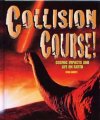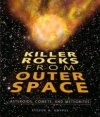Killers from Outer Space Additional Information
Share this:
- Share via email (Opens in new window) Email
- Click to share on Facebook (Opens in new window) Facebook
- Click to share on X (Opens in new window) X
- Click to share on Pinterest (Opens in new window) Pinterest
- Click to share on Reddit (Opens in new window) Reddit
- Share to Google Classroom (Opens in new window) Google Classroom
- Click to print (Opens in new window) Print
Information about asteroid impacts is available at impact.arc.nasa.gov/ (NASA).
You can learn more about near-Earth objects at neo.jpl.nasa.gov/ (NASA), spaceguard.esa.int/NScience/NScience.html (European Space Agency), and www.space-frontier.org/Projects/TheWatch/ (Space Frontier Foundation).
For a movie about asteroid impacts, go to www.jpl.nasa.gov/multimedia/neo/index.html(NASA).
For information about the Torino impact hazard scale, see neo.jpl.nasa.gov/torino_scale.html (NASA) and web.mit.edu/newsoffice/2005/torino.html (Massachusetts Institute of Technology).
Monastersky, Richard. 1998. Chunk of death-dealing asteroid found. Science News 154(Nov. 21):324. Available at http://www.sciencenews.org/pages/sn_arc98/11_21_98/fob1.htm.
Peterson, Ivars. 2004. Pinpointing killer asteroids. Science News Online (March 27). Available at http://www.sciencenews.org/articles/20040327/mathtrek.asp.
Sohn, Emily. 2003. Killer space rock snuffed out ancient life. Science News for Kids (Nov. 26). Available at http://www.sciencenewsforkids.org/2003/11/killer-space-rock-snuffed-out-ancient-life-2/.
______. 2003. Asteroid lost and found. Science News for Kids (Nov. 5). Available at http://www.sciencenewsforkids.org/2003/11/asteroid-lost-and-found-2/.
Lesson Plans for Teachers:
Blast That Asteroid
www.nasaexplores.com/show_58_teacher_st.php?id=030410150604
NASA
Books recommended by SearchIt!Science:
 |
Asteroid Impact — Douglas Henderson
Published by Dial Books/Penguin Putnam, 2000.
Sixty-five million years ago, an asteroid traveling at 60,000 miles per hour slammed into Earth, plunging the planet into darkness. This book tells that story, mixing colorful illustrations with scientific explanations and diagrams to explain how an asteroid came to hit Earth and the devastation the crash caused. It discusses the dinosaurs that roamed Earth, the possible origins and kinetic energy of the asteroid, what happened upon impact, and the ghostly world that was left in the asteroid’s wake. |
 |
Collision Course! Cosmic Impacts and Life on Earth — Fred Bortz
Published by Millbrook Press, 2001.
What happens when comets and asteroids collide with planets? Meet the people who study and try to understand occurrences such as the Tunguska event of 1908 in Siberia or the crash of Comet Shoemaker-Levy 9 into Jupiter in 1994. Explore how scientists detect, and how they might be able to prevent, “near-Earth objects” from colliding with Earth. |
 |
Killer Rocks from Outer Space: Asteroids, Comets and Meteorites — Steven N. Koppes
Published by Lerner Publishing, 2004.
Yes, there are lumps of dusty ice silently streaking through space as you read this. So what, you might ask? Well, just one of these lumps is capable of wiping out our entire civilization—if it were to hit Earth. This fascinating book traces the history of impacts upon planet Earth. It explains how scientists track asteroids and comets. Also, it goes in depth into how we recognize impact craters and scars, using Meteor Crater in Arizona as an example and discussing astroblemes and tektites. Then, the book discusses what happened to the dinosaurs, mass extinctions, impacts upon other planets, and the present and future threat of meteor collisions. |
Power Words
asteroid One of the millions of rocky objects that orbit the Sun, mostly in the region between Mars and Jupiter. Asteroids are smaller than planets. They can be as large as several hundred miles across and as small as a speck of dust.
Most asteroids orbit the Sun between Mars and Jupiter (in an area called the asteroid belt), but once in a while one comes close to Earth and even crashes into it. Scientists now believe that the dinosaurs died out because a big asteroid hit Earth about 65 million years ago. When it hit, it sent up a huge cloud of dust that blocked out sunlight, killing off lots of life.
comet A mass of ice, frozen gases, and dust particles that travels around the Sun in a long path. When a comet comes close to the Sun, it can be seen in the sky as a bright object with a glowing head and a long, streaming tail.
Although a comet might look like a fuzzy star in the sky, it is not like a star at all. Comets are cold, not hot—astronomers sometimes call them “dirty snowballs”—and they have no light of their own. Instead, they only shine when they come close enough to the Sun for their ice to melt into a cloud of glowing gas and dust.
Richter scale A scale that is used to rate the strength of earthquakes. The Richter scale ranges from 1 to 9. Each increase on 1 on the scale means an increase of 10 times the strength. An earthquake rated at 6 is 10 times more powerful than one rated at 5, and 100 times more powerful than one rated at 4.
Copyright © 2002, 2003 Houghton-Mifflin Company. All rights reserved. Used with permission.
